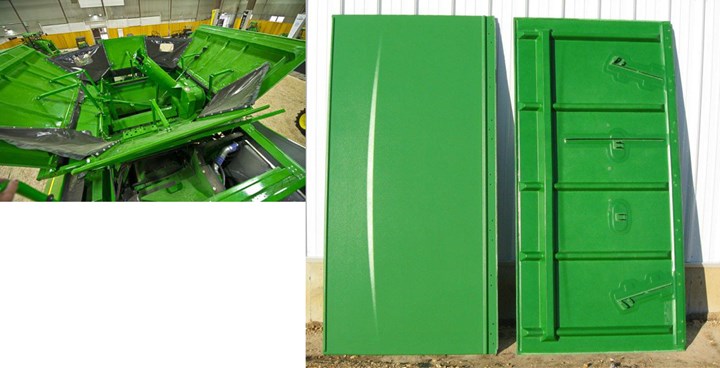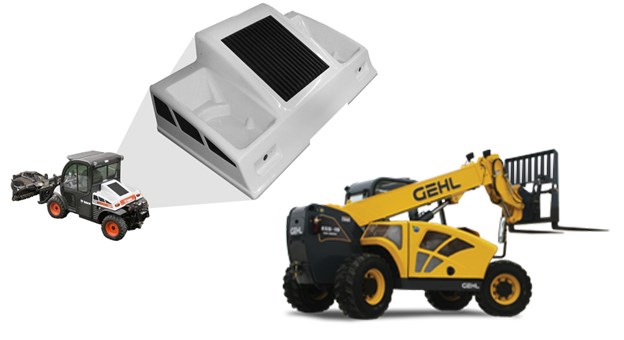Combining plastics and composites for Class A parts without tools
Plastics Unlimited’s patented TEC process cuts secondary finishing and meets multiple demands for medium-volume parts.
Share
Producing composite parts with a class A finish is not the Holy Grail — there are plenty of companies that do this on a routine basis. However, doing so using resin infusion without expensive tooling or gelcoats and at a rate of one part per hour? Well, that is something unique.
From plastics to composites
Plastics Unlimited was started 25 years ago by Terry and Nancy Kieffer, explains their son Dakota Kieffer, sales and marketing director for the company. “They were farmers in Iowa and had started looking for a new and growing industry,” he explains, “They thought plastics would be better than welding or woodworking and they did not want to compete with their neighbors. They looked at injection molding, rotational molding and recycling plastics, but then came across thermoforming, and really understood it.” (Thermoforming uses heat and vacuum/ pressure to shape thermoplastic sheets into shaped parts.)
Then Kieffer’s parents came into contact with a company making glass fiber reinforced plastic (FRP) parts. “They saw how strong FRP was, but also that it required a long, multi-step process, roughly four hours per part — so, only two parts were produced per day,” he continues. “Compared to our production in plastics, they felt that was too slow. We were turning parts every 2-6 minutes — maybe even producing 5-6 parts at once — so, thousands of parts per day.” To bridge the gap, Kieffer’s father came up with the idea of using a thermoformed plastic shell as a tool.
The result is a tool-less composite parts manufacturing process, which Plastics Unlimited calls Tool-less Engineered Composite (TEC). “It removes the gelcoat and tool release steps,” says Kieffer. “Also, when you thermoform, you can inspect the Class A surface and make sure it’s perfect.” In other words, the Class A surface isn’t hidden underneath a composite laminate. “All that was needed was a single thermoforming tool, and the process still made sense for our plastic parts customers.”
Patented composite process
Kieffer notes that a composite combines two materials to make a better material than either constituent alone. “We are combining two different types of materials and two different processes to make a better product.” Notably, a product that comprises plastic, resin and glass fiber to offer a unique mix of benefits. “Plastics perform much better in impact than gelcoats,” he explains. “It is also possible to print any texture or design on the plastic, for example a camouflage pattern. The plastics also offer a lot of depth of image with no buffing afterwards, which removes secondary finishing operations.”
Meanwhile, compared to spraying chopped fiber in an open molding process, this patented technology enables a higher fiber content, higher quality and no/low volatile organic compounds (VOCs). He points out that spraying chopped fiber onto plastics for tubs and spas is not patented. “We always use vacuum infusion to make the FRP part of the product,” says Kieffer, adding “our parts have a smooth finish, so we are more of a light RTM with caul plates. We’re always taking it to the next level. Customers come to us with a problem and we try to find a solution that works for their needs. We are very innovative, and we patent our new developments.”

Example parts
One of the parts that Plastics Unlimited produces using this process is a grain tank extension for John Deere combines made by Deere & Company (Moline, Ill. U.S.). “This is the very top part of the combine, that is open, where the grain sits,” Kieffer explains. “Compared to the original steel tank, ours is more durable. We make it with a smooth finish inside and John Deere green on the outside with black inserts at the corners. It is the largest grain tank extension available and can fold flat. It is a more engineered product compared to our competitors, with foam and ribs added to increase stiffness.” Some steel reinforcement is also required, which is actually molded in, says Kieffer, “not secondarily bonded.”
This combination of materials and process imparts a lot of toughness to the finished part. “We have videos of dropping concrete blocks on these parts,” says Kieffer. By molding steel fixtures, he says pull-out strength can 4-5 times that achieved with secondary bonding using industry standard methyl methacrylate adhesives.
Plastics Unlimited can make up to 2,500 of these parts per month, with some of the panels measuring 5 feet by 7 feet. “This would require expensive tooling, if not made using our method,” says Kieffer, noting that TEC can be used for quite large parts — up to 8 feet by 11 feet. “Our parts can have more shape and geometry versus steel. This is important to our customers because it lets them differentiate via styling. Our UV resistance is also better than most gelcoats.”

Plastics Unlimited supplies parts for a range of companies, including Harley-Davidson and Gehl telescoping lifts. “We also do soft-touch parts that look and feel like leather,” says Kieffer. The company has also made truck components for Navistar and recreational vehicle (RV) parts for Winnebago. “We prefer volume production, from 100,000 parts per year down to a few hundred.”
Kieffer acknowledges that long fiber injection (LFI) and resin injection molding (RIM) are competitive processes, “but the parts are not as structural as what we do. For example, a combine grain tank holds 400 bushels, which exerts 10 tons of force. RIM parts, which are not heavily reinforced, simply can’t meet this type of load requirement and RIM tooling is very expensive.”
Continued development
“We do a lot R&D work with our customers,” says Kieffer. “We explore different resins, foams, laminates, layers of reinforcement and finishes, and then show them prototypes so that they can do tests very quickly. We will try to make the part more manufacturable, looking at how to reduce cost and improve performance, plus meet the various in-service requirements, such as extreme hot and cold temperatures and impact.”
Plastics Unlimited has 100,000 square feet of production space and 75 employees, including a team of three engineers. Its 5-axis Thermwood CNC machine enables in-house tooling production and also quick prototyping, the latter important to customers as they seek to shorten development timelines.
“We are also working with mass transit and aerospace companies,” he continues. “A lot of subway interiors are currently FRP with gelcoat plus aluminum structure behind it. They need lightweight but also a cosmetic surface finish. We’re looking at a wide range of applications, including medical, electrical and construction.”

The company is also looking at thermoforming carbon fiber reinforced plastics (CFRP). “We have formed Tepex and Polystrand materials and are working on various developments with a medical customer,” says Kieffer. “We can use high-end plastic materials like Kydex and back it with CF/epoxy for aerospace, or materials like polyurethane, polycarbonate and ABS, which provide a nice exterior finish and are cost-effective. Behind these latter plastics we can use glass fiber-reinforced polyester, vinylester or epoxy laminates.”
Plastics Unlimited operates at the intersection of plastics, metals and composites, says Kieffer. “Our parts are typically 30 to 40 percent lighter than steel. But we find the market still needs quite a bit of education about what composites are and what they can do.” All the same, the company sees a lot of potential for future growth. “Not all materials work together, and especially not all resins work with all plastics,” he notes. “We’ve done so much testing and development over the years that we understand the landscape and possibilities very well. We have a unique expertise and offer a unique range of possible solutions.”
Related Content
JEC World 2023 highlights: Recyclable resins, renewable energy solutions, award-winning automotive
CW technical editor Hannah Mason recaps some of the technology on display at JEC World, including natural, bio-based or recyclable materials solutions, innovative automotive and renewable energy components and more.
Read MoreWatch: A practical view of sustainability in composites product development
Markus Beer of Forward Engineering addresses definitions of sustainability, how to approach sustainability goals, the role of life cycle analysis (LCA) and social, environmental and governmental driving forces. Watch his “CW Tech Days: Sustainability” presentation.
Read MoreNovel composite technology replaces welded joints in tubular structures
The Tree Composites TC-joint replaces traditional welding in jacket foundations for offshore wind turbine generator applications, advancing the world’s quest for fast, sustainable energy deployment.
Read MoreCirculinQ: Glass fiber, recycled plastic turn paving into climate solutions
Durable, modular paving system from recycled composite filters, collects, infiltrates stormwater to reduce flooding and recharge local aquifers.
Read MoreRead Next
All-recycled, needle-punched nonwoven CFRP slashes carbon footprint of Formula 2 seat
Dallara and Tenowo collaborate to produce a race-ready Formula 2 seat using recycled carbon fiber, reducing CO2 emissions by 97.5% compared to virgin materials.
Read MoreVIDEO: High-volume processing for fiberglass components
Cannon Ergos, a company specializing in high-ton presses and equipment for composites fabrication and plastics processing, displayed automotive and industrial components at CAMX 2024.
Read MorePlant tour: Daher Shap’in TechCenter and composites production plant, Saint-Aignan-de-Grandlieu, France
Co-located R&D and production advance OOA thermosets, thermoplastics, welding, recycling and digital technologies for faster processing and certification of lighter, more sustainable composites.
Read More






















